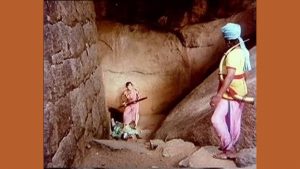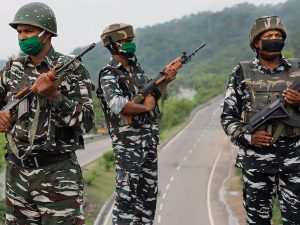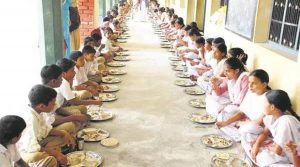Today Current Affairs: 12th November 2021 for UPSC IAS exams, State PSC exams, SSC CGL, State SSC, RRB, Railways, Banking Exam & IBPS, etc
Table of Contents
UN Assistance Mission In Afghanistan (UNAMA):

The United Nations Assistance Mission in Afghanistan (UNAMA) recently held a meeting with the women activists and applauded their courage and affirmed that the UN will continue to stand by the people of Afghanistan.
- UNAMA was established on 28 March 2002 by United Nations Security Council Resolution 1401.
- It was basically established to assist the state and the people of Afghanistan in laying the foundations for sustainable peace and development.
- Its original mandate was to support the implementation of the Bonn Agreement (December 2001).
- Reviewed annually, this mandate has been altered over time to reflect the needs of the country.
- UNAMA is an integrated mission.
- This means that the Special Political Mission, all UN agencies, funds and programmes, work in a multidimensional and integrated manner to better assist Afghanistan according to nationally defined priorities.
Bonn Agreement:
- Bonn was a closed-door negotiation; participants were isolated, outside contact was limited during the negotiations, and there was no publicity until after the agreement was signed.
- The existing nominal head of state (Rabbani) was sidelined and did not participate, and the Taliban were completely excluded from the Bonn negotiations.
- The United Nations and several other international actors played major roles in pushing the negotiations forward, and the Bonn Agreement was blessed by the U.N. Security Council.
- The Bonn Agreement set an ambitious three-year political and administrative roadmap which was, by and large, followed:
- The Emergency Loya Jirga (grand council) of June 2002 established the transitional administration, a new Constitution was ratified in early 2004, and presidential and parliamentary elections were held in 2004 and 2005.
- The term ‘Special Political Mission’ encompasses entities that are not managed or directed by the Department of Political and Peacebuilding Affairs (DPPA) such as the Office of the Special Adviser on the Prevention of Genocide.
Integrated Theatre Commands:

In a fresh push towards the creation of theatre commands to fight the next wars in an integrated manner, the Department of Military Affairs (DMA) under the Defence Ministry has asked the three services to conduct studies on the structures of the new formations and submit their reports by April next year.
- India currently has 19 military commands with 17 of them service-oriented. While both the Army and the Air Force have seven commands each, the Navy has three.
- India also has a Tri-Service Command Andaman and Nicobar Command besides the Strategic Forces Command (SFC), which looks after the country’s nuclear stockpile.
- An integrated theatre command envisages a unified command of the three Services, under a single commander, for geographical areas that are of strategic and security concern.
- The commander of such a force will be able to bear all resources at his disposal — from the Army, the Indian Air Force, and the Navy with seamless efficacy.
- The integrated theatre commander will not be answerable to individual Services.
- This will help in better planning and military response and also bring down cost.
- While the cost may go up in the immediate future since all theatres would have to be armed with sufficient systems, it will prove to be cost-effective in the long term as all acquisitions will be a unified one.
- It will provide a unified approach to fighting the future wars.
November 11: Onake Obavva Jayanti

From this year, the Karnataka government has decided to celebrate ‘Onake Obavva Jayanti’ on November 11 throughout the state
- Onake Obavva is a woman warrior who fought the forces of Hyder Ali single-handedly with a pestle (‘onake’ in Kannada) in Chitradurga in the 18th century.
- She died protecting the Chitradurga Fort, which was ruled by Madakari Nayaka in the 18th century.
- Obavva is considered to be the epitome of Kannada pride and celebrated along with other women warriors of Karnataka state.
- Onake Obavva’s courage and quick thinking have been praised by the people of Karnataka, especially in the Chitradurga region, where a stadium is named after her.
- Inspired by Onake Obavva, in 2018, the Chitradurga police started ‘Obavva Pade’, a squad of women police constables to protect and educate women in the district.
- This was later extended to Bangalore.
Services Export Target:

Minister of Commerce and Industry Piyush Goyal said that India is poised to achieve a services export target of one trillion dollars by 2030.
- He was addressing the Global Services Conclave-2021 in New Delhi.
- The Minister said that in 2020, India became the 7th largest services exporter in the world, moving up the ladder by two positions.
- Emphasizing that India had the potential to become the top services exporter in the world, Mr. Goyal said that the services sector is boosting India’s transition from an Assembly economy to a Knowledge-based economy.
- Goyal said that today India’s services export largely comprises of IT and IT-enabled services. He stressed that we need to focus on other potential growth sectors.
Service Exports from India Scheme:
- It was introduced in April 2015 for 5 Years under the Foreign Trade Policy of India 2015-2020.
- Earlier, this Scheme was named as Served from India Scheme (SFIS Scheme) for Financial Year 2009-2014.
- Under the scheme, the government gives 3-5% incentive on net foreign exchange earned in the form of duty-credit scrips.
- Scrips can be used for payment of basic and additional Customs duties on goods imported.
Leonids Meteor Shower:

The annual Leonids Meteor Shower has begun and will be active between 6th and 30th November, with peak activity expected on 17th November.
- Meteor: It is a space rock or meteoroid that enters Earth’s atmosphere.
- Meteoroids are objects in space that range in size from dust grains to small asteroids.
- Most are pieces of other, larger bodies that have been broken or blasted off. These come from comets, asteroids, planets and the Moon.
- When meteoroids enter Earth’s atmosphere (or that of another planet, like Mars) at high speed and burn up, the fireballs or “shooting stars” are called meteors.
- Fireballs are larger explosions of light and color that can persist longer than an average meteor streak. This is due to the fact that fireballs originate from larger particles of cometary material.
- When a meteoroid survives its journey through the atmosphere and hits the ground, it’s called a meteorite.
- Meteor Shower:
- When Earth encounters many meteoroids at once, it is called a meteor shower.
Comets, like Earth and the other planets, also orbit the sun. Unlike the nearly circular orbits of the planets, the orbits of comets are usually quite lop-sided. - As a comet gets closer to the sun, some of its icy surface boils off, releasing lots of particles of dust and rock (meteoroids).
- This comet debris gets scattered along the comet’s path, especially in the inner solar system (including planets Mercury, Venus, Earth and Mars).
- Then, several times each year as Earth makes its journey around the sun, its orbit crosses the orbit of a comet, which means Earth encounters a bunch of comet debris.
- Meteor showers are named for the constellation where the meteors appear to be coming from. So, for example, the Orionids Meteor Shower, which occurs in October each year, appears to be originating near the constellation ‘Orion the Hunter’.
- When Earth encounters many meteoroids at once, it is called a meteor shower.
Leonids Shower:
- The debris that forms this meteor shower originates from a small comet called 55P/Tempel-Tuttle in the constellation Leo, which takes 33 years to orbit the sun.
- The Leonids are considered to be a major shower that features the fastest meteors which typically travel at speeds of 71 km per second, although the rates are often as low as 15 meteors per hour.
- The Leonids are also called fireballs and earthgrazer meteors.
- Fireballs, because of their bright colours, and earthgazer, because they streak close to the horizon.
- A Leonid shower turns into a meteor storm every 33 years and when it happens hundreds to thousands of meteors can be seen every hour.
- The last Leonid meteor storm took place in 2002.
- A meteor storm should have at least 1,000 meteors per hour.
CRPF Launches Chaupal:

The Central Reserve Police Force (CRPF) has decided to start a ‘Chaupal’ like get-together for its personnel to vent their mental agony.
- Chaupal is a popular meeting activity in the rural areas.
- Once or twice a week, 18-20 personnel will sit in chairs in a circle outdoors, perhaps under a tree.
- The chaupal, which shall be planned beforehand, will be attended by personnel of all ranks, all of whom will be in civilian clothes.
- Company, platoon, or section commanders must necessarily be part of the chaupal “group sharing exercise”.
- Senior officials will interact with the troopers to know their difficulties and other issues which can lead to mental stress.
- Regular Yoga classes, daily exercises, counselling and other remedial measures are there in the system but something more has to be done to weed out the mental stress and fatigue of the forces.
- There have been over 100 cases of suicides in the largest para- military force from 2020 till September 2021. The highest number of fratricides have been committed in 2021.
- In 2017, 2018, 2019 and 2020 the number of suicides among the CRPF were 38, 38, 43 and 60, respectively.
- Reasons for Suicide:
- Domestic problems, illness, financial problems, sanction of leave to the jawans, and sometimes tough postings are some of key factors behind the suicides.
Introducing Millets In The Mid-Day Meal Scheme:

Flagging “critical” levels of malnutrition and anaemia among children, the Union Government has urged the states to explore the possibility of introducing millets in the mid-day meal scheme, now known as PM Poshan.
- Millets or nutri-cereals, which include Jowar, Bajra, and Ragi, are rich in minerals and B-complex vitamins, as well as proteins and antioxidants, making them an ideal choice for improving the nutritional outcome of children.
About the Mid-Day meal scheme:
- The scheme guarantees one meal to all children in government and aided schools and madarsas supported under Samagra Shiksha.
- Students up to Class VIII are guaranteed one nutritional cooked meal at least 200 days in a year.
- The Scheme comes under the Ministry of HRD.
- It was launched in the year 1995 as the National Programme of Nutritional Support to Primary Education (NP – NSPE), a centrally sponsored scheme. In 2004, the scheme was relaunched as the Mid Day Meal Scheme.
- The Scheme is also covered by the National Food Security Act, 2013.
- Objective: Address hunger and malnutrition, increase enrolment and attendance in school, improve socialisation among castes, provide employment at grassroot level especially to women.
- The MDM rules 2015, provide that:
- The place of serving meals to the children shall be school only.
- If the Mid-Day Meal is not provided in school on any school day due to non-availability of food grains or any other reason, the State Government shall pay food security allowance by 15th of the succeeding month.
- The School Management Committee mandated under the Right to Free and Compulsory Education Act, 2009 shall also monitor implementation of the Mid-day meal Scheme.
SMILE Scheme:

The Ministry of Social Justice and Empowerment has formulated this scheme for Support for Marginalized Individuals.
- “SMILE stands for Support for Marginalized Individuals for Livelihood and Enterprise”.
- Focus of the scheme is on rehabilitation, provision of medical facilities, counseling, basic documentation, education, skill development, economic linkages etc.
- It includes sub scheme – ‘Central Sector Scheme for Comprehensive Rehabilitation of persons engaged in the act of Begging’.
- The scheme would be implemented with the support of State/UT Governments/Local Urban Bodies, Voluntary Organizations, Community Based Organizations (CBOs) , institutions and others.
- According to the Census 2011 total number of beggars in India is 4,13,670 (including 2,21,673 males and 1,91,997 females) and the number has increased from the last census.
- West Bengal tops the chart followed by Uttar Pradesh and Bihar at number two and three respectively. Lakshadweep merely has two vagrants according to the 2011 census.
- Among the union territories, New Delhi had the largest number of beggars 2,187 followed by 121 in Chandigarh.
- Among the northeastern states, Asam topped the chart with 22,116 beggars, while Mizoram ranked low with 53 beggars.
Portable Oxygen Cans:

After oxygen cylinders, it’s everyday-use portable oxygen cans that are now witnessing brisk sales across the country, with escalating air pollution levels and increased travel and outdoor activities. It is also being used by those recovering from COVID-19.
- Sales of these portable oxygen cans, according to industry experts, have doubled post-Diwali, and going by the current trend they are expected to triple in the coming weeks.
- Delhi-NCR alone claims to bring in 65% of the sales, while Mumbai, Bengaluru and Pune also are witnessing a steady climb in demand for this product.
- This when medical doctors are not ready to give an all-clear for the product, stating that it can actually delay medical intervention and lead to a false sense of well-being.
- According to doctors, these cans are not useful and they should not be recommended
- Technically, a patient in need of oxygen will require at least 1 litre per minute. While these portable oxygen spray cans can have up to 12 litres of oxygen, they will last for about 10 minutes or even less. They shouldn’t be seen as a medical intervention.
- These oxygen spray cans will hardly help in times of acute respiratory failure. One requires a continuous, high flow of oxygen supply with a proper setting.
- These spray cans may only be used in areas with severe air pollution, for certain sports activities, high-altitude climbing and expeditions, mountaineering, sky expeditions etc.
- As oxygen supports combustion, storing these at homes is also hazardous.
Bhaskaracharya National Institute For Space Applications And Geo-Informatics (BISAG-N):

The Indian Army has inked a Memorandum of Understanding with the Bhaskaracharya National Institute for Space Applications and Geo-Informatics (BISAG-N), Gandhinagar, Gujarat.
- This MoU will facilitate exchange of knowledge and collaboration in the fields emerging technologies for development of GIS and IT based Enterprise Resource Planning Software, Training Content, Telecasting of Audio-Visual Content under a holistic partnership for projects which have the prior approval of Army Management Studies Board (AMSB).
- The MOU will leverage the relative advantage of BISAG-N to support training and evolving innovative solutions to boost operational capabilities of the Indian Armed Forces.
- BISAG-N which is an autonomous scientific society under the Ministry of Electronics and Information Technology, Government of India will act as a medium of exchange of knowledge and collaboration in the fields of emerging technologies.
Project – 75, Yard 11878 Was Delivered To The Indian Navy:

The fourth submarine of the Project – 75, Yard 11878 was delivered to the Indian Navy
- Christened ‘Vela’, the submarine was launched on 06 May 19, and has completed all major harbour and sea trials including weapon and sensor trials.
- The submarine would soon be commissioned into the Indian Navy and enhance the Indian Navies capability.
- Project – 75 includes construction of six submarines of Scorpene design.
- These submarines are being constructed at Mazagon Dock Shipbuilders Limited (MDL) Mumbai, under collaboration with M/s Naval Group, France.
- Three of these submarines are already in commission with the Indian Navy.
Global Resilience Index Initiative:

A global coalition of ten organisations launched the Global Resilience Index Initiative (GRII).
- It was launched during the UNFCCC Conference of Parties (CoP) 26 adaptation day (8th November 2021), it will be the world’s first curated, open-source reference index.
- It has been launched to build a universal model for assessing resilience to climate risks.
- It will provide reference data on climate and natural hazard risks to inform and protect populations and economies, particularly in emerging and developing countries, form a basis for mobilising the trillions of investment needed to meet the Paris goals on climate-resilient development.
- It can be used in aggregated risk management across sectors and geographies.
- Goal: The coalition wants to achieve two immediate goals.
- First, they want to provide global open reference risk data developed using insurance risk modelling principles.
- Second, they want to provide shared standards and facilities applicable to a wide range of uses:
- Corporate climate risk disclosure.
- National adaptation planning and reporting.
- Planning of pre-arranged humanitarian finance.
- Partners & Supporters: GRII has been initiated with partial funding and in-kind contributions from the insurance sector and partner institutions such as:
- Coalition for Disaster Resilient Infrastructure (CDRI)
- Coalition for Climate Resilient Investment (CCRI)




